Distribution Case Study: The Devil We Know
Written by Jess Fuselier
Introduction
“
WHAT FASCINATED MOST ABOUT THIS STORY IS THAT IT WAS REALLY A MICROCOSM FOR A MUCH MORE PERVASIVE ISSUE: THE LACK OF REGULATION OF MORE THAN 80,000 SYNTHETIC CHEMICALS. MOST PEOPLE DON’T REALIZE THESE CHEMICALS ARE RELEASED ONTO THE MARKET WITHOUT ANY SIGNIFICANT OUTSIDE TESTING.”
STEPHANIE SOECHTIG
When filmmaker Stephanie Soechtig (Tapped, Fed Up, and Under the Gun) first heard the news that chemical giant DuPont was poisoning the people of Parkersburg, West Virginia, and the residents were fighting back with one of the largest class-action lawsuits in history, she knew that she had the topic for her next film. Passionate about environmental issues and a mother of two young sons, Soechtig was propelled to make a film that would raise awareness for corporate injustice and the unregulated chemicals that exist in our homes and bodies.
Due to the success of her last films, Stephanie and her producer Kristin Lazure are invited to bring the project, The Devil We Know, to Sundance Institute’s 2016 Catalyst Forum, a program that connects investors and funders with film projects. The Catalyst team was struck by the film’s portrayal of the environmental scandal.
Explains Alana Hauser, then manager of Catalyst, now senior manager of Women at Sundance Institute: “We knew that our creative investor community would appreciate this film’s timely investigation, and [given their past award-winning films] we believed this acclaimed team could deliver.” The film’s potential to “impact the course of environmental justice in the United States” would inspire passion within the Catalyst community.
During the Catalyst Forum, The Devil We Know is in the early stages of production. At Catalyst, they raise a total of $710,000 for the production budget—$310,000 in donations, $125,000 in recoupable grants, and $275,000 in equity. The final production budget ends up being $1,630,000—$875,000 of the amount raised is recoupable; the remainder is non-recoupable. With the financing they are able to secure through Catalyst, the team is able to move into full production for the film.
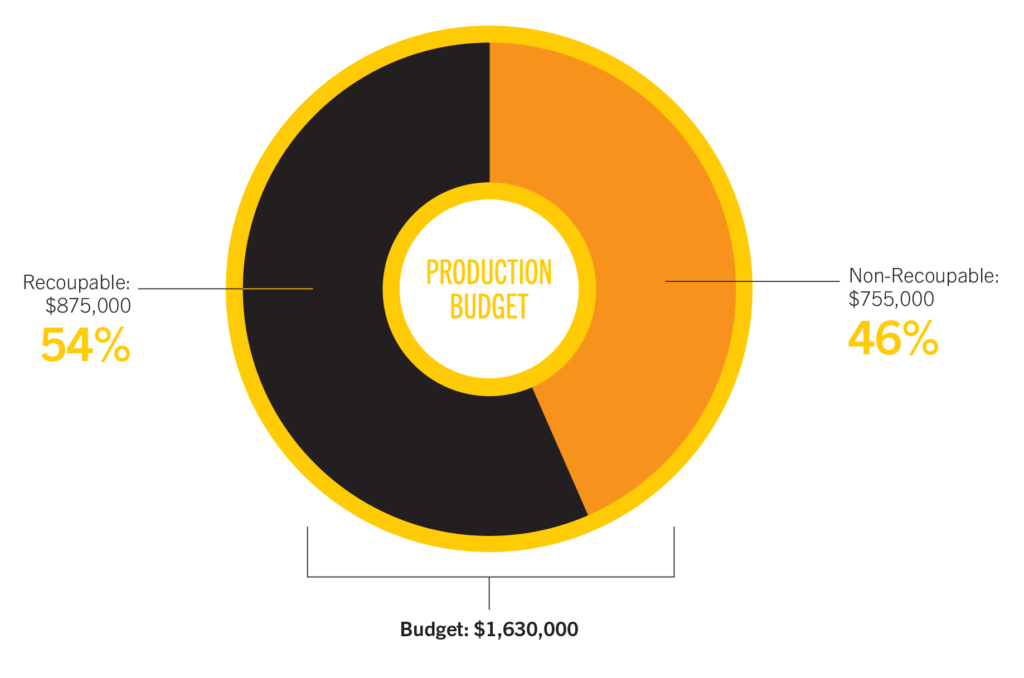
The team begins editing the film in May of 2017, while finishing up production, pulling together a solid cut in time to submit the film to the Sundance Film Festival in August. Once the team finds out the film has been accepted, they work hard to handle all outstanding post-production tasks, polish the cut, arrange for film publicity at the Festival by hiring PR consultant Renee Ridinger, and begin structuring an impact strategy for the film’s release.
The film premieres at the 2018 Sundance Film Festival and receives positive reviews and audience reactions. The film team hopes this will lead to discussions around potential all-rights deals with distributors. Roco Films is the first to come to the table during the Festival, discussing a deal for international sales for roughly $100,000. The film team and their sales agent Cinetic Media continue this conversation during the Festival, while waiting for any all-rights deals to surface. Unfortunately, no distributors come forward with a significant all-rights offer in hand.
A few months following the Festival, after a meaningful all-rights deal seems unlikely, Cinetic Media approaches Netflix to take SVOD rights for a price in the low six figures. Before finalizing the deal, Stephanie, Kristin, and their Cinetic reps work hard to negotiate a 90-day holdback with Netflix. They want to be sure they have a window to exploit TVOD sales, with the hopes of generating revenue to pay their investors back. Once this is agreed upon, the film team decides to take the Netflix deal and work with Roco on international sales.
Considering Creative Distribution
Stephanie and Kristin commit to an alternative distribution strategy by selling off two specific portions of the film’s revenue streams: SVOD and international sales. With these two revenue streams accounted for, Stephanie and Kristin want to be sure they explore all other possible revenue streams in order to make a return to their investors. In addition to return for their investors, Stephanie and Kristin want to place a strong emphasis on a robust impact distribution campaign.
With this in mind, they decide to explore the Creative Distribution Fellowship. Having self-distributed her first film, Tapped, Stephanie feels she can build on her previous distribution knowledge to craft and execute an efficient, successful creative distribution campaign for The Devil We Know. In April 2019, Stephanie and Kristin accept the Creative Distribution Fellowship.
Sundance Institute’s Creative Distribution Fellowship includes:
- A guaranteed $33,000 marketing/distribution grant
- Consultation and assistance with strategic planning from Sundance Institute’s Creative Distribution team
- Digital distribution delivery and licensing at a 25% reduced rate through Quiver, a part of Premiere Digital
- Promotional support from Sundance Institute’s marketing team
- Connections to leading independent film consultants, vendors, and other distribution and marketing agencies
THE DISTRIBUTION PLAN
Setting Distribution Goals
“
WE FELT STRONGLY THAT THIS STORY AND THIS ISSUE COULD REALLY TOUCH A NERVE ACROSS ALL DEMOGRAPHICS. IT NOT ONLY SPEAKS TO ENVIRONMENTAL HEALTH ADVOCATES, BUT IT SPEAKS TO PARENTS WHO WANT TO MINIMIZE THEIR EXPOSURE TO CHEMICALS, AND IT SPEAKS TO BLUE COLLAR FAMILIES WHO LIVE IN FACTORY COMMUNITIES. OUR JOB REALLY BECAME MAKING SURE WE GOT THE FILM IN FRONT OF ALL OF THESE PEOPLE.”
KRISTIN LAZURE
The team roots the majority of their distribution goals in impact. To maximize the amount of impact they can achieve with the film, they decide to forego a theatrical release in order to cut down on distribution costs. Instead, they focus on outreach and nontheatrical distribution to reach as wide an audience as possible.
At the onset, Kristin and Stephanie outline four distinct goals centered around impact and one pertaining to financial return:
- Amplify the film and the underlying issues by forgoing a theatrical release and focusing on outreach and impact.
- Create a groundswell in the environmental health community and use this momentum to expand their reach to a larger audience of the unconverted.
- Turn the film into a movement and move the needle on this important issue.
- Recoup as much money as possible for their investors.
With these four goals, Stephanie hopes to combine a unique set of impact distribution tactics that will help raise awareness for this important issue that’s affecting large communities throughout the U.S.
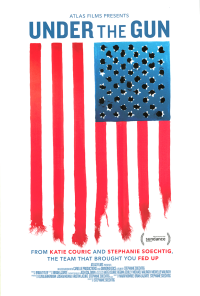
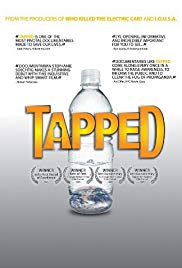
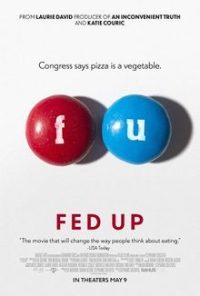
Creating a Release Pattern
Stephanie and her team begin by mapping out release avenues they feel will contribute the most to their impact goals. In order to conserve budget and resources, the team takes theatrical distribution off the table and focuses on nontheatrical distribution. From there, they build in other ancillary releases and impact avenues they feel will help bring more awareness to this issue:
- Nontheatrical impact screenings
- Impact campaign
- Educational distribution
- DVD
- TVOD
Identifying the Audience
Given her history of focusing on deeply rooted social issues as the subject of her films, Stephanie has extensive experience in mobilizing audiences around captivating non-fiction media. Through her work on her prior three films—Tapped, Fed Up, and Under the Gun—Stephanie has a loyal audience that she hopes will be champions of The Devil We Know throughout the course of the release campaign. She also aims to reach outside of her fanbase by targeting environmental-health communities that have a vested interest in this topic in order to expand her reach.
Stephanie uses her experience rallying viewers around issues during the audience-mapping phase to brainstorm who might be interested in the subject matter of The Devil We Know. Kristin and Stephanie start by identifying a few large interest groups that they hope will expand into other smaller, niche interest groups to target:
- Environmentally conscious community
- Mom groups focused on organic and nontoxic products and lifestyles
- Disease communities (those highlighted in the film)
- Firefighters (due to the chemicals used in the creation of their uniforms)
Using these four communities, they begin to research specific groups who have an affiliation with these communities that they can target through their outreach efforts. They also form outreach lists for communities who have been affected by the practices of DuPont Chemical, keeping these on hand for when they begin outreach for their nontheatrical tour and impact campaign.
Assembling a Team
The team’s focus on impact distribution greatly influences who they decide to bring on board for the distribution and marketing of The Devil We Know. Shortly after the Sundance Film Festival, the team decides to hire Film Sprout and Picture Motion to manage their nontheatrical screenings and a call-to-action impact campaign. Film Sprout specifically oversees the semi-theatrical campaign for the release.
Having worked with Picture Motion in the past—on the successful impact distribution of Stephanie’s film Fed Up, which reached over 65,000 people, and Under the Gun, which partnered with prominent organizations such as Everytown for Gun Safety for their grassroots screening campaign—the team feels they’ll be the right partner to craft and execute a similar impact campaign strategy for The Devil We Know.
With an impact team already in place, Kristin and Stephanie focus on finding teammates who can assist with the marketing of the film. In May 2019, the Creative Distribution Initiative holds an advisor summit for the Devil We Know team, bringing in experts who focus on different aspects of marketing—trailer editing, key asset creation, digital marketing, website design and UX, and general distribution and marketing best practices. These conversations help Stephanie and Kristin assess the areas of marketing where they need the most support, and they begin hiring the team they feel will drive the most success.
With their primary focus on impact, the filmmakers know a robust digital marketing campaign is going to be a crucial driver of success. They decide to work with 3rd Impression (3i), a boutique digital-marketing company based out of New York, which has worked with numerous independent films including Unrest, We the Animals, and Lizzie. They hire Wheelhouse Creative, a marketing agency out of New York, who’s worked on films such as Eighth Grade, American Honey, and Amy, to cut their trailer. They also realize a well-designed website will aid in mobilizing communities around their impact campaign, so they enlist Full Stack Creative to build a visually captivating website with a user experience that drives impact campaign involvement.
Stephanie has had gripping posters for all of her films, and she knows this one should be no different. To help create an image that sticks in people’s mind, Stephanie and Kristin bring on the team at Scrab Labs to build their key art. Having worked with them in the past on Stephanie’s film Under the Gun, Stephanie and Kristin trust that the creative team at Scrap Labs will be able to deliver a poster that grabs audiences.
Stephanie and Kristin handle PR on their own and forego the expense of hiring a publicist. With the team in place, Stephanie and Kristin begin working with the impact and marketing teams to craft a holistic campaign that leverages the distribution of the film.
THE DISTRIBUTION STRATEGY
Setting a Release Pattern
Stephanie and Kristin want the distribution of The Devil We Know to act in service of the impact campaign, while potentially generating revenue that they can use to pay their investors back. With this in mind, they set out to approach release avenues that either drive impact, have a low financial barrier to entry, or have a broad audience reach.
“
WE KNEW PEOPLE WOULD WATCH THE FILM AND WANT TO KNOW HOW THEY COULD REDUCE THEIR EXPOSURE TO THE TOXIC CHEMICAL AT THE HEART OF THE FILM, AS WELL AS OTHER UBIQUITOUS CHEMICALS. WE WANTED TO GIVE THEM THOSE TOOLS IN A WAY THAT DIDN’T FEEL OVERWHELMING OR COST PROHIBITIVE.”
STEPHANIE SOECHTIG
The Film Sprout team begins to compile lists of nonprofits, interest groups, schools, and individuals that may be interested in screening the film in their communities. On top of this research, Stephanie and Kristin provide the Film Sprout team with lists of people from their work identifying their audience—including people who have been affected by DuPont Chemical practices in the regions highlighted in the film, and allied organizations working to bring attention to this pressing issue. With comprehensive outreach lists in hand, the Film Sprout team begins to reach out to each of these groups and individuals to make them aware of the film and explain the ways they can go about bringing a screening of the film to their community. Film Sprout fields all incoming interest and arranges all semi-theatrical screenings as they’re confirmed.
The call-to-action impact campaign is run by Picture Motion. Stephanie is hoping that the campaign for The Devil We Know can find the same success as the action campaign for Fed Up, in which nearly 100,000 people participated. Based on the themes of the film, Kristin and Stephanie create a chemical detox challenge, a seven-day plan readers can follow to detox their homes and lifestyles of the myriad of harsh chemicals we’re exposed to on a daily basis, as well as read about ways they can further their positive impact on the planet. Picture Motion takes this idea and creates a comprehensive strategy for the campaign, heavily integrating the call-to-action tasks for the audience into the website. In addition to campaign logistics, such as where people will go to carry out actions associated with the campaign, Picture Motion takes the lead on drafting a timeline, comprehensive communication strategy, and marketing and promotion plan for the campaign.
The team feels educational sales can also help generate awareness. They decide to bring on Tugg to handle educational sales, selling library copies of the film to organizations and universities and streaming the film on Tugg’s educational video-on-demand platform, as well as manage the semi-theatrical campaign once the Film Sprout contract timeline comes to an end. Tugg takes a 35% cut of any nontheatrical screenings they book and educational sales they make. Tugg uses their extensive database of schools, universities, and organizations to craft a curated outreach list for educational sales. They use this outreach list to determine which entities would be interested in purchasing an educational copy of the film to screen at events or in classrooms.
Digital and Other Ancillary Releases
In addition to building awareness for the film, Stephanie and Kristin hope the digital release of the film will bring in revenue that they can use to pay their investors back. They work with Premiere Digital for their TVOD release through the Creative Distribution Initiative’s preferred 25% off rate. They decide to release on iTunes and Google Play through Premiere Digital and directly put the film on Amazon Video Direct, which allows filmmakers to upload their film to Amazon to buy, rent, or watch without having to pay a third party aggregator to do that work for them. Premiere Digital also pitches the film to other VOD outlets such as InDemand, Comcast, Vudu, Steam, and Dish. Vudu, InDemand, Comcast Xfinity, and Dish all decide to take the film. They aim to launch TVOD presales in September 2018 with an October 2018 live date.
They also work with distribution company Allied Vaughn for the DVD release of the film. Though they know this release avenue most likely won’t generate a significant amount of revenue, they want to ensure people have the ability to watch the film no matter where they’re located and what their viewing preferences are. Allied Vaughn produces physical product on demand so there’s very little up-front cost to the filmmaker. The team spends $640 up front for the DVD case wrap and design.
Distribution Budget
“
WE WERE FORTUNATE TO BE CONNECTED WITH A NUMBER OF INDIVIDUALS AND FAMILY FOUNDATIONS IN THE ENVIRONMENTAL-HEALTH SPACE WHO BELIEVED IN THE FILM AND OUR VISION FOR OUTREACH AND IMPACT. THEY WERE INCREDIBLY GENEROUS WITH US, AND WE WANTED TO STRETCH THOSE DONATIONS AS FAR AS WE COULD TO EXPAND THE REACH OF THE FILM.”
KRISTIN LAZURE
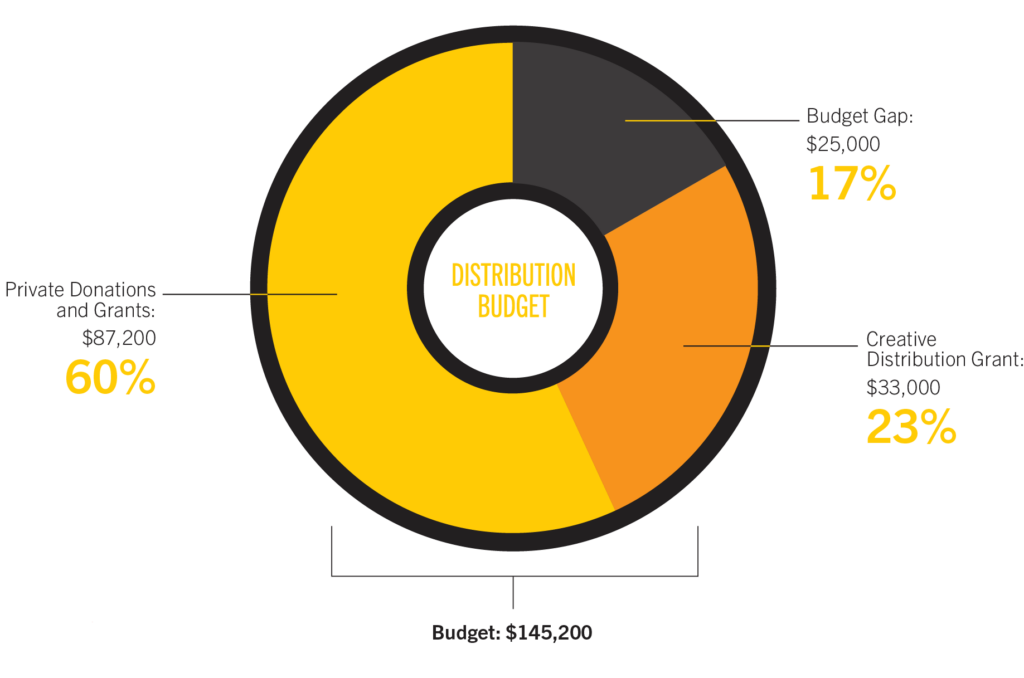
The team combines the Creative Distribution Fellowship grant with private donations and an additional grant to make up their distribution budget. Compared to many nonfiction filmmakers, Stephanie and Kristin are in a unique position to source some of the distribution financing from Atlas Films, a production company Stephanie founded with Michael and Michelle Walwrath. The total distribution budget amounts to $145,200. In addition to the $33,000 creative distribution grant, they raise $87,200 through private donations and grants, $25,000 of which comes from the Fledgling Fund.
They end up with a $25,000 budget gap, which Atlas Films covers, in addition to nominal costs associated with the film’s distribution and outreach, such as web-server charges and the DVD packaging design. The company is in a fortunate position to cover these costs and the gap, seeing as the film may not be lucrative for the company since the distribution goals are primarily rooted in impact. A majority of their distribution budget is spent on the impact campaign and digital marketing, with the remainder going towards deliverables, key assets, and the website design and construction.
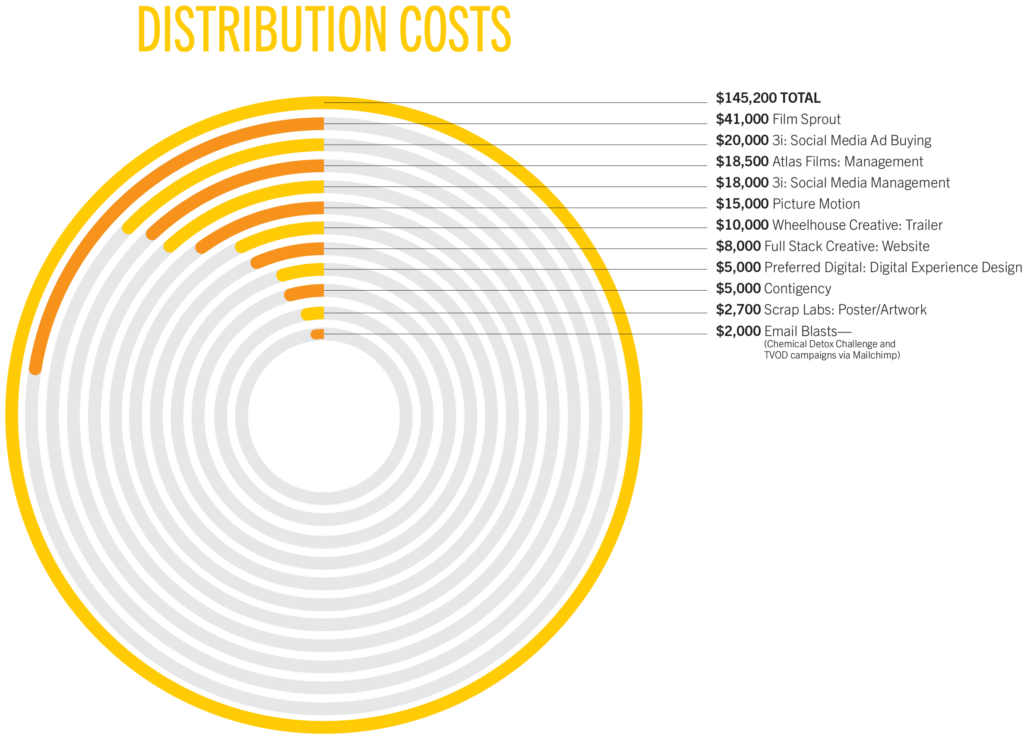
IMPLEMENTATION
Promotional Assets
Stephanie and Kristin know an alluring poster, trailer, and website will be crucial to their impact campaign efforts. They begin working with Scrap Labs early on in the distribution planning phase and come to the Creative Distribution advisory summit with a few poster versions already in hand. Since part of the film focuses on the harmful C8 chemicals found primarily in Teflon, the film team and Scrab Labs decide on an image of smoke in the shape of a skull rising from a nonstick frying pan.
Daniel Perlaky, a freelance creative director and summit advisor, provides feedback on their poster and website to help maintain a cohesive creative presence for the film throughout all main marketing assets. Stephanie and Kristin relay this helpful feedback to the Scrap Labs team, which leads them to their final version. In addition to visual aesthetics, the team brainstorms taglines to include on the poster. Each of Stephanie’s past films has included a tagline, and the team feels that one will be integral to the marketing campaign for this film. After long deliberations, the team lands on “The chemistry of a cover-up.”
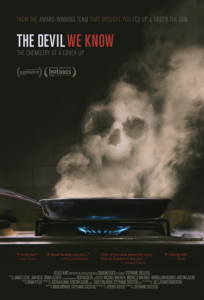
After the advisory summit, the team strikes a deal with Wheelhouse to edit their trailer. For $10,000, Stephanie and Kristin are given five rounds of edits and a couple short video spotlights for marketing purposes. Usually this fee amount only covers the trailer edit, but the team at Wheelhouse is passionate about the film and graciously includes the two short marketing videos.
Stephanie and Kristin enlist the team at Fullstack Creative to revamp the film’s website. The team puts a big focus on the website, since it will function as a hub for the social-impact campaign they construct with Picture Motion. They aim to create a true-crime vibe to lure people into the website. For $8,000, Fullstack Creative creates a robust website, including sections where users can study the facts about DuPont’s cover-up and take action to rid their homes of toxic chemicals, in addition to call-outs throughout the site to sign up, take action, and watch the film. The Fullstack Creative team implements basic search engine optimization (SEO) on the website in order for it to appear in the top search results when browsing for the film online. The website maintains a cohesive aesthetic throughout and compliments the other key assets created for the film. The team sets out to pair all of these key assets with digital marketing to drum up the most awareness and engagement.
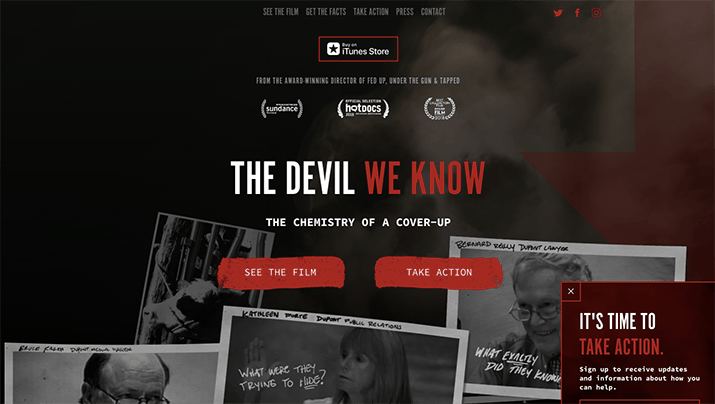
Impact Campaign
The first part of the impact campaign starts in July 2018 when Film Sprout begins the semi-theatrical screening campaign. They start with outreach, using the lists they created in addition to the outreach research they were given by the film team, to find people and organizations interested in screening the film in their communities. They also receive outside inquiries from organizations and individuals who have heard about the film through other means, such as the film’s premiere at the Sundance Film Festival. The grassroots screening and discussion events Film Sprout facilitates begin in Portland, Oregon, in August 2018.
On September 10, 2018, the film team decides to launch the redesign of the website. This has a significant impact on the number of screening inquiries Film Sprout receives. In the end, 54% of all confirmed screenings reach out to Film Sprout via the film’s website or other organic channels (e.g., calling or emailing Film Sprout directly).
The team launches the chemical detox challenge, which is managed and overseen by Picture Motion, on October 16, 2018, the same day as the TVOD launch for the film. By making the film readily accessible to many audiences through the digital release, they hope that this will drive more engagement with the chemical detox challenge. The team uses the website as the main hub for the social-impact campaign, hosting the step-by-step detox challenge under the website’s “take action” section, in addition to smaller, yet still meaningful, tasks users can take if they don’t want to go through the full process of the seven-day detox, such as signing a petition.

To promote the detox challenge, Picture Motion constructs a robust email promotion campaign. A total of 14 emails are sent throughout the campaign to those who opt in to the chemical detox challenge. Each newsletter has a different theme, some of which Picture Motion crafted with different partners, such as Hayward Score, Collaborative on Health and the Environment, and Made Safe, to come up with a specific message. In additional to Picture Motion’s promotional efforts, the film team works with 3i to craft a robust digital-marketing campaign around the digital release and the chemical detox challenge. Kristin also writes a blog post for the Sundance Institute website that explains why the team is carrying out this call-to-action impact campaign.
Digital Release
The team plans to launch their TVOD presales September 12, 2018, to coincide with their trailer launch through IndieWire. They initially planned to launch presales September 4, 2018, but decided to push the date out once they found out when IndieWire would be promoting the trailer. However, the film is still made available for presales September 4 because the date change order doesn’t go through properly with the Premiere Digital team. Instead of taking it down and relaunching on September 12, the team decides to keep the presales live and wait to do any promotion until September 12 once IndieWire launches the trailer.
Stephanie and Kristin work with 3i to craft ads around the trailer launch and the digital release that will hopefully boost their presale numbers. Meanwhile, 3i starts with an ad for the trailer release, which does exceptionally well. Within five days of launching the trailer ad on Facebook, the post is shared 13,000 times and receives 742,000 impressions. They continue to post frequently to their social media channels, promoting the presale with the hopes that they’ll climb in the iTunes charts.
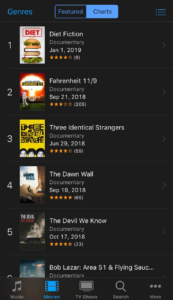
On October 16, 2018, the film goes live on all TVOD platforms at the same time they launch the chemical detox challenge. Leading up to this launch date, the team taps into their past and present networks to ask for help with promoting the digital launch of the film. Stephanie and Kristin reach out to their email list, which includes followers of Stephanie’s past films, to spread the news about The Devil We Know’s digital release. They also reach out to NGO supporters such as Toxic Free Future, Center for Environmental Health, and Safe States, and tastemakers such as Erin Brockovich, Beauty Counter, and The Intercept, to ask them to promote the release on their social media channels, on their email lists, and via word of mouth. Through their relationship with iTunes, the Creative Distribution team also helps line up preferred placement on the iTunes main page for the release.
Traditional Press and Marketing
The film team decides not to hire a PR consultant for the distribution of The Devil We Know and handles the work as a team. For the release, Kristin and Stephanie feel the most important PR work will be finding an impactful partner for the trailer release. They aim to find a partner that will help expand beyond the east and west coasts, which are already exposed to the release of high-profile independent documentaries, and reach middle America, which has been most affected by the harmful practices of DuPont.
The team sets their sights on USA Today. As Kristin Lazure explains, “We felt like USA Today offered us the best opportunity to connect with a nationwide audience that cut across political lines.” They reach out to their Festival publicist, Renee Ridinger, for advice. She gives them contact information for USA Today and advice on how they should craft their outreach letter. Unfortunately, Stephanie and Kristin have no luck connecting with them after multiple cold calls.
They also reach out to the Los Angeles Times’ Amy Kaufman, who wrote a piece on the film during the 2018 Sundance Film Festival, but they do not receive a response. They then do a cold outreach to Variety and the Hollywood Reporter and receive no responses from any of these outlets. Since IndieWire covers the Sundance Institute and the Creative Distribution Initiative, the Creative Distribution team suggests that Stephanie and Kristin reach out to them for the trailer exclusive. IndieWire takes the exclusive and launches the trailer on September 12, 2018.
Digital Marketing
Digital-marketing company 3i oversees and manages the entire digital-marketing strategy for The Devil We Know’s distribution campaign. Since the majority of their release strategy focuses on the digital release and the impact campaign via the website, Stephanie and Kristin feel it’s best to focus most of their promotional efforts on digital marketing.
At the onset of their collaboration, 3i’s Matt Delman and his team take Stephanie and Kristin through an in-depth audience-identification exercise. They start by brainstorming all of the audiences they feel might be drawn to the film, which include people interested in government cover-ups, alternative medicine, and documentaries, as well as environmentalists and people with illnesses that are specifically caused by C8 or could be related.
The 3i team takes these interest groups and puts them into buckets and begins to search social media groups tied to these interests. Their goal is to create a bucket that has no less than 1 million people and no more than 10 million people. They then take these buckets, determine which would be most effective for ad targeting, and use this as their audience foundation for the social media ad campaign.
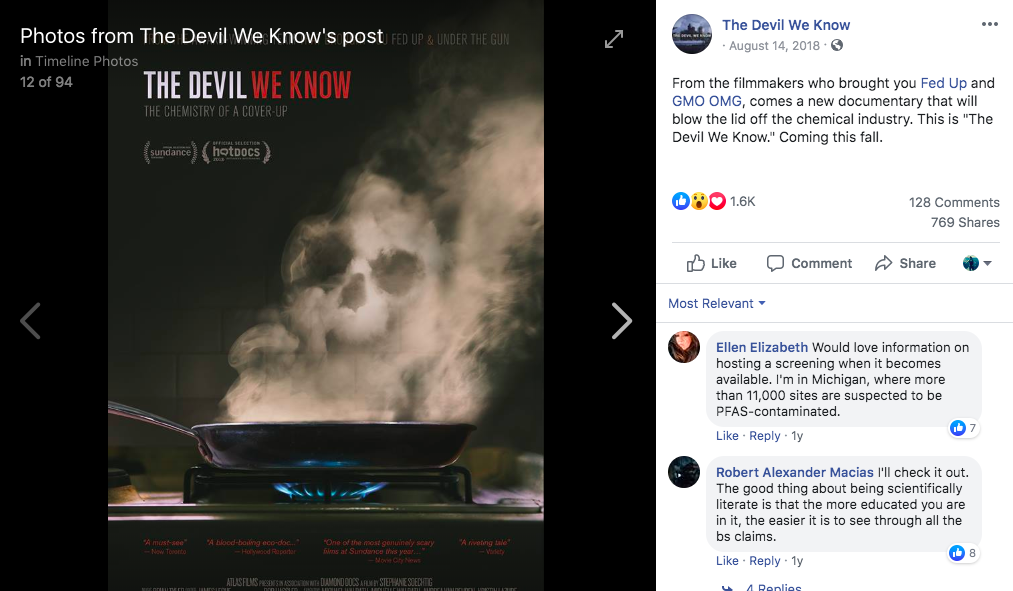
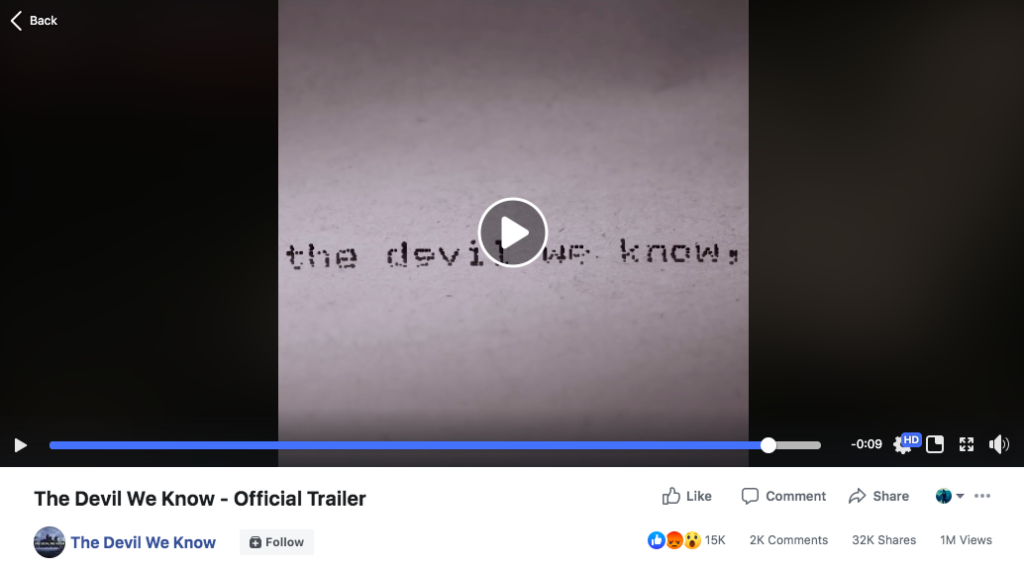
Then the team maps out the specific ad campaigns they’ll run throughout the course of the release. They decide to run ads for their poster and trailer launch and then focus on the TVOD release. The 3i team first runs a poster ad on Facebook and Instagram to generate awareness for the film. On Facebook, this ad serves 31,332 impressions and is shared 546 times, and on Instagram, it serves 20,922 impressions and is shared 64 times. They spend a total of $500: $250 on the Facebook ad and $250 on the Instagram ad.
Then, the 3i team works with the filmmakers and Wheelhouse to make sure the trailer is set up to succeed on social, which involves a few rounds of notes, editing the aspect ratio for mobile, and adding captions. They allocate $3,500 for the trailer launch. The ad serves 1.5 million impressions, but the trailer actually reaches almost 3 million unique people due to the high number of shares. With 32,500 shares, the Devil We Know trailer is one of 3i’s most shared pieces of content ever. The post also received 1 million views, 15,000 reactions, and over 1,500 comments.
Using the momentum from the successful trailer promotion, the team moves on to promote the digital release of the film. On September 29, 2018, they create a social media post to promote the TVOD launch with a link to the preorder page on iTunes for Facebook, Instagram, and Instagram Stories; they spend $1,000 across all three platforms to boost the post. The posts on Instagram receive 173,000 impressions, and the Facebook post receives 16,678.
In addition, 3i creates a series of spots tailored to specific target audiences to be used to promote the TVOD release. They launch each of these spots individually to their target audiences leading up to the release date and then runs all four of them concurrently during the release within the same campaign, allowing Facebook to automatically optimize for the spots that perform the best and serve the right spot to the right person. Wheelhouse Creative also delivers a 30-second cutdown of the trailer.
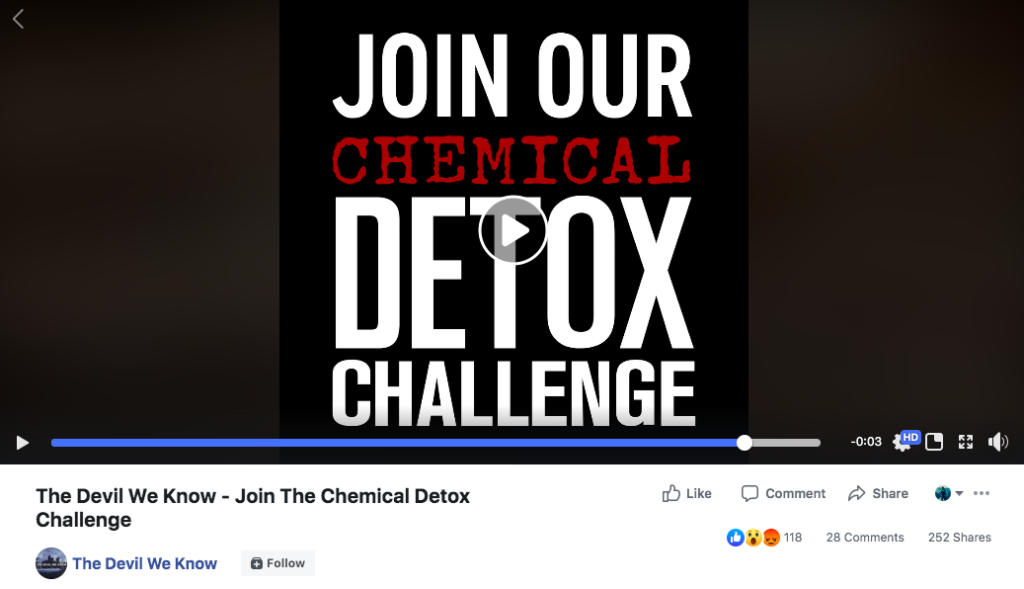
On October 16, 2018, the same day as the launch of the chemical detox challenge, the 3i team posts a 35-second video to Facebook promoting the challenge and the TVOD sales. They also post that same video to Instagram. For the TVOD release, the 3i team also creates a draft post Stephanie and Kristin can share out to their community partners to encourage them to help promote the digital release of the film. For the rest of October, the 3i team continues to promote the digital release across The Devil We Know’s Facebook and Instagram channels. Later, they release and boost spots adapted from the iTunes extra content, including one featuring Erin Brokovich and another about pet birds that have dropped dead from the fumes of a Teflon pan.
In addition to the social media promotion, Stephanie and Kristin send out a newsletter promoting the digital release and chemical detox challenge.
Despite all of their digital-marketing efforts, the TVOD sales for the film don’t perform as well as the film team is hoping for, given its viral trailer launch. On October 29, 2018, a little over two weeks after their launch, the team decides to pause all of the digital-marketing ads and reassess their strategy. They discuss dropping the price of the film on TVOD platforms, but ultimately feel it’s best to keep as is. As Kristin describes, “There was a consensus amongst the film team that the price likely wasn’t what was deterring sales of the film. Mindful that one of our goals was to recoup as much money as possible for investors during the Netflix holdback window, we decided to hold firm on the price and only drop it to 99 cents once the film became available on Netflix in January.”
OUTCOMES
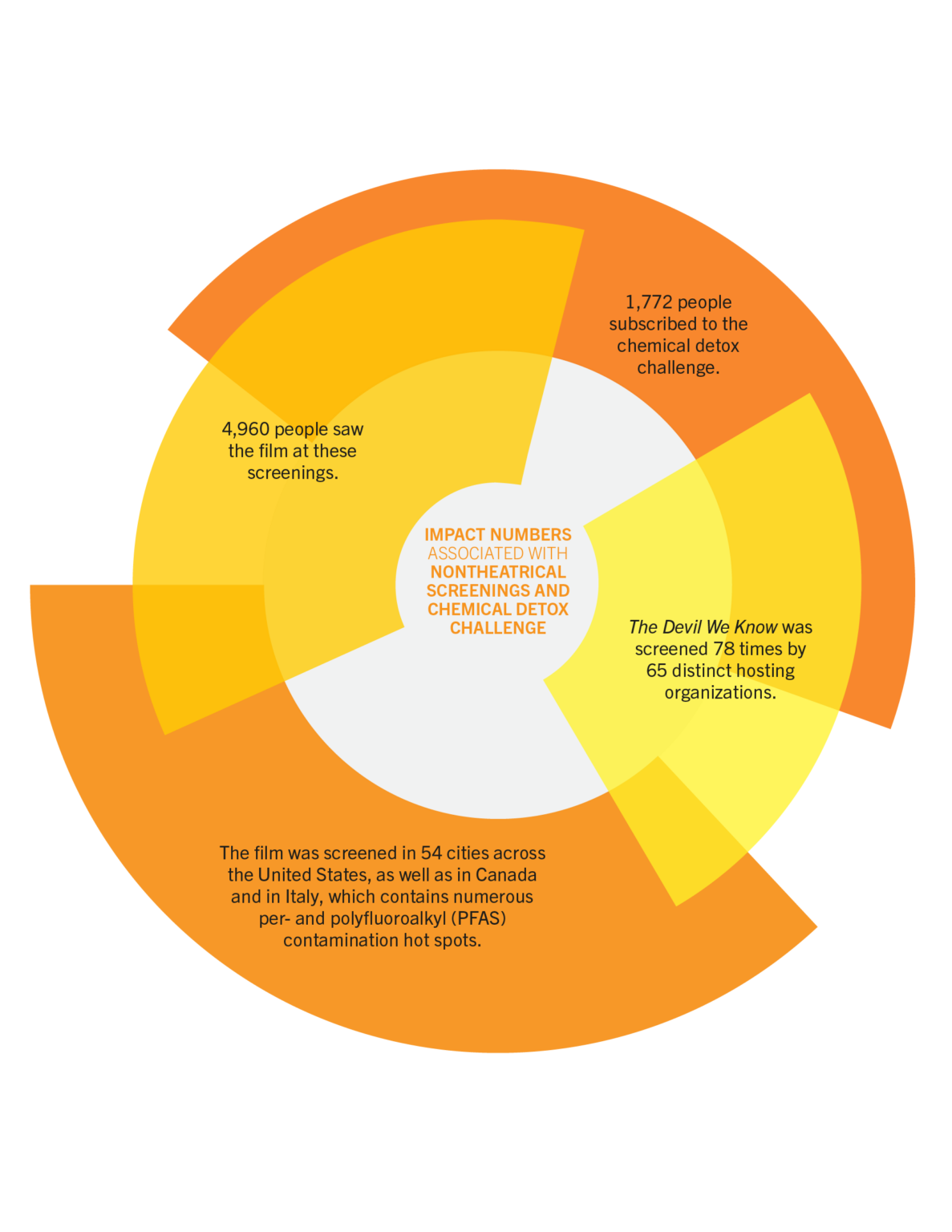
Brief Summary of Numbers
Through the nontheatrical screening campaign with Film Sprout, The Devil We Know was screened 78 times by 65 distinct hosting organizations, such as the NRDC, Lululemon, Carolina Nature Coalition, New York Water Project, and the Sierra Club. Approximately 4,960 people saw the film at these screenings. The film was screened in 54 cities across the United States, as well as in Canada and in Italy, which contains numerous PFAS contamination hot spots.
Through the call-to-action impact campaign led by Picture Motion, 1,772 people subscribed to the chemical detox challenge, through which 7,500 Bitly link clicks were tracked—3,897 on TVOD links (Amazon, iTunes, Google Play), 2,491 on the “take action” page, 50 on the “take action” guide, 800 on the home page, and 370 on the screening tour page. Partners’ promotional efforts for the chemical detox challenge reached 79,400 followers across social media platforms.
The trailer release on Facebook reached 3 million unique people and garnered 32,500 shares.
As of November 2019, the film has grossed $341,750. They received $200,000 for their Netflix deal and $103,746 through their Roco deal. They’ve made $23,100 through TVOD sales and $3,483 through DVD sales. They received a cash prize of $2,500 from the Vancouver International Film Festival and have made $8,921 on nontheatrical screenings through Film Sprout. They’re currently waiting on the educational-sales revenue total from Tugg.
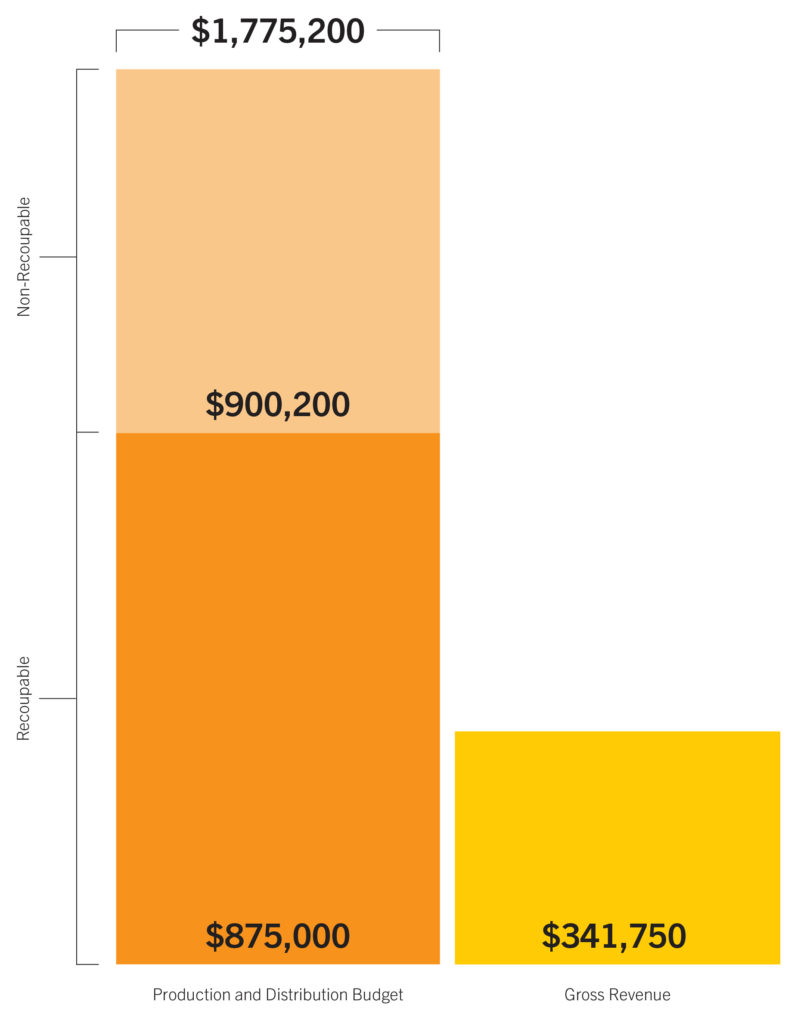
Meeting Their Goals
The Devil We Know team focused most of their distribution goals on impact. They wanted to use the distribution of the film as a catalyst for change. Investing most of their distribution budget on impact consultants and digital marketing, Stephanie and Kristin hoped that the team they enlisted could create a groundswell big enough to move the needle on this important issue. They worked closely with the 3i team to craft a digital-marketing campaign that would amplify both the release of the film and its impact campaign.

Stephanie and Kristin were pleased with the well-curated design and functionality of the website, and they felt it helped promote the film’s message. They were also extremely happy with the trailer release on Facebook. With its viral nature, reaching 1 million viewers, Stephanie and Kristin believe this digital-marketing campaign drove the most awareness for the film. The film team has received numerous emails from members of impacted communities thanking them for creating a tool that helps spread awareness.
They’ve also received many emails and social media messages from people who have watched the film saying that they’ve tossed their Teflon in favor of safer alternatives. At a Capitol Hill screening that took place in the summer of 2019, congressional staffers voiced to Kristin that they hadn’t been able to raise awareness for the issue until they had the film to use as a catalyst. Also, after a number of years of legislative inaction at the federal level, there have recently been a number of hearings on the PFAS issue that have included testimony from community members featured in the film.
Stephanie and Kristin had higher hopes for the TVOD release. Though they devoted part of their digital-marketing campaign to the promotion of this release and believed they could generate revenue from TVOD sales that would enable them to pay some of their investors back, the TVOD sales were low. As Lazure says, “After the trailer went viral, we had really high hopes that the film would continue to generate buzz and perform well on TVOD and the screening tour, so we were incredibly disappointed when the trailer success didn’t carry over as prominently as we had expected.”
As far as TVOD sales, the Devil We Know team is not alone, as there has been a steep decline in this area of the market for independent films.
CONCLUSION AND TAKEAWAYS
1. Self-distribution is a full-time job.
Social media posts, website, digital release, impact campaign—self-distribution is a time-intensive process that involves a lot of energy from the filmmakers.
2. Even if you’ve self-distributed a film before, things change quickly in this industry. You can learn a lot about the distribution and its changing landscape by self-distributing more than one of your films.
Distribution has changed significantly in the past 10 years since Stephanie self-distributed her film Tapped. Revenue streams that used to be lucrative are drying up, and it’s harder than ever to get your work seen by a large audience given the amount of content that people can now access. An all-rights distribution offer would have been ideal for The Devil We Know; however, despite it being well-reviewed out of the Sundance Film Festival and receiving great audience reactions, there was no such deal in sight. As an alternative, they embarked on a self-distribution journey and aimed to make the biggest impact they possibly could with the film.
3. Traditional PR is still important to have for a successful independent film release, even if you’re not doing a theatrical run.
Throughout the course of the campaign, Stephanie and Kristin realized how important a well-crafted marketing campaign was for the distribution and impact of a film. They saw success in the digital-marketing space by the virality of their trailer and devoted a lot of resources to promoting the film in this space. However, social media alone can’t shoulder the weight of the entire distribution and impact campaign for a film.
The traditional modality of PR is still crucial to building awareness for an independent documentary in today’s ecosystem. In hindsight, Stephanie and Kristin would have devoted at least some resources to help spread the word about the film through more traditional PR means. However, working with a small distribution budget compared with most independent-distributor spends, Stephanie and Kristin had to make hard decisions surrounding what they decided to invest most of their budget in. As Kristin states, “We definitely wish we could have afforded a publicist and/or a small theatrical run that would have likely ensured solid publicity. But I don’t know what we would have sacrificed. We had a limited amount of money to accomplish our goals, and we couldn’t have everything on our wish list.”
4. Impact campaigns are expensive. Research all of your options to decide which is best for your team and your release strategy.
There are many ways to go about crafting an impact campaign for an issue-based documentary film. Stephanie and Kristin decided to work with outside teams they’d worked with in the past who specialize in crafting and executing impact campaigns to cut down on bandwidth constraints. However, looking at the results of these campaigns, Stephanie and Kristin wonder what other ways of creating an impact campaign could have spread more awareness for the film and the issue at hand. Still, the film went far in achieving its impact goals by sparking an important conversation, which continues to grow and make people recognize this important problem in our society.
Appendix: About the Film and Film Team
Film Synopsis
When a handful of West Virginia residents discover DuPont has been pumping its poisonous Teflon chemical into the air and public water supply of more than 70,000 people, they file one of the largest class-action lawsuits in the history of environmental law.
- Advisors
- Matt Delman—Digital marketing
- Daniel Perlaky—Creative direction
- Elissa Greer-arko and Russell Swartz—General distribution & marketing
- Liz Cook—Kickstarter
- Grey Watson—Trailer
- Distribution Team
- 3rd Impression—Digital marketing
- Picture Motion—Impact campaign
- Film Sprout—Semi-theatrical campaign
- Film Collaborative—Festival campaign
- Roco—International sales
- Tugg—Educational distribution
- Premiere Digital—Digital distribution
- Allied Vaughn—DVD distribution
- Wheelhouse—Trailer
